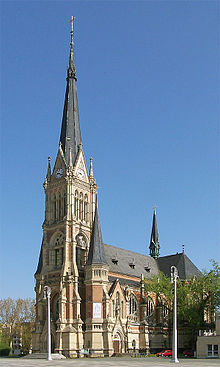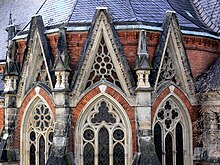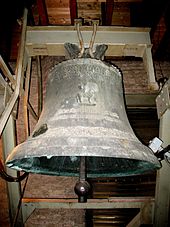Petrikirche (Chemnitz)
The Petrikirche is a Protestant church in Chemnitz , which was built from 1885 to 1888 as a neo-Gothic hall church based on a design by Leipzig architect Hans Enger . The church is on Theaterplatz and thus in the immediate vicinity of the opera house and the Chemnitz art collections .
The church with 1200 seats is made of sandstone and brick , is 59 m long and 36 m wide. Its iron roof structure was made by the Königin-Marien-Hütte ; today's tower bells come from the Lukaskirche , which was destroyed in the war .
Along with the castle church, it is one of two churches belonging to the St. Petri castle parish in the Evangelical Lutheran regional church of Saxony .
history
At the same time as the St. Pauli parish, the parish of St. Petri was separated from the mother parish of St. Johannis in 1875 . However, the now independent congregation only received its own church a decade later.
On April 16, 1883, the City Council of Chemnitz gave the parish a 1200 m² property on Schillerplatz . Two years later, on July 23, 1885, the foundation stone was laid after that of the Leipzig architect Hans Enger emerged victorious in an architectural competition from 58 submitted designs. On August 18, 1887, the golden tower cross was placed at a height of 82 m and on December 1 of the same year the bells were consecrated .
The construction of the church cost a total of 700,000 marks .
description
"The magnificent portal with the large relief on Wimperg above, which depicts the saying: 'Come to me all who are laborious and laden' and that, like the rest of the sculptural decoration of the church, is based on plaster models by the sculptor Werner Stein ( Leipzig) is made that the main tower flanking stair towers, closed cross-ships at the sanctuary itself leaning against polygon extensions for sacristy and baptistery , the large, flat pointed arch covered rose window lends to illuminate the nave, all combined to create a harmonious overall picture and St. Petrikirche has a very special character. "
inner space
“The splendid interior of the church with 1200 seats corresponds to this. The broad nave and nave rise up to 22 meters in the crossing ; The subdued light of the day streams through the large mosaic windows into the consecrated room. In the lofty pointed arched windows of the apse , glorious stained glass shine, depicting the birth, crucifixion and resurrection of the Lord and, like the figure windows in the baptistery, came from the studio of the court glass painters Hertel & Lersch in Düsseldorf. The altar, pulpit, baptismal font and lectern, which are made of fine, white, French limestone and Zöblitz serpentine stone, stand out effectively from the colored furnishings of the chancel and its vaulting . The altar is decorated with two beautiful reliefs depicting the sacrifices of Isaac and Christ in Gethsemane; Statuettes of the four evangelists decorate the pulpit, two others, Luther and Melanchthon , the organ loft , all designed by the Leipzig sculptor Werner Stein from the master hand of the sculptor Peter Horst (Leipzig), while the beautiful baptismal font is dedicated to the architect Theodor Roschig (Chemnitz) comes from. "
organ

The organ was built by the organ building workshop Friedrich Ladegast in Weißenfels with 57 registers at that time on three manuals and a pedal with 3902 pipes and consecrated together with the church on October 18, 1888. The instrument was rebuilt twice in the past century by the Dresden organ building workshop Gebrüder Jehmlich . First Jehmlich replaced Ladegast's mechanical play system in 1913 with pneumatic cone chests and a pneumatic console, made the second manual swellable, changed the disposition, placed the Vox humana separately in a swellable remote mechanism, and made the organ Baroque during the second renovation in the 1950s.
The condition of the organ deteriorated very much. The A. Schuke company planned a completely new building in the mid-1970s; However, the poor state of construction of the church prevented this. In 1987 the organ fell silent when the church was closed due to construction defects; the control lines between the console and the organ were cut.
After the turnaround and the repair of the church, building a new organ was again up for debate. However, it was decided to continue using the existing historical substance (including prospectus and about 1 ⁄ 3 of the pipes from Ladegast). Since there were no records of Ladegast's mechanical play equipment, which had been removed in 1913, only a restoration of the pneumatic action and wind chests appeared, and thus a return of the organ to the state of 1913 feasible. This was done from October 2007 by the Vleugels company . The restoration was supported with the fundraising campaign “A Queen for Chemnitz”. On October 19, 2008 for the 120th anniversary of the parish fair, the organ sounded again for the first time as part of a festive service. It is prepared for the installation of a second console with an electric action.
|
|
|
|
||||||||||||||||||||||||||||||||||||||||||||||||||||||||||||||||||||||||||||||||||||||||||||||||||||||||||||||||||||||||||||||||||||||||||||||||||||||||||||||||||||||||||||||||||||||||||
-
Pairing :
- Normal coupling: II / I, III / I, III / II, I / P, II / P, III / P
- Super octave coupling: II / I, III / II
- Sub-octave coupling: III / II
- Subsidiary register:
- Playing aids : general coupling, crescendo roller .
Bells
First bell
The Petrikirche received the first chime in B flat major in 1887. Three bells with the chimes b 0 , d 1 and f 1 were cast by the Leipzig bell foundry G. A. Jauck . They had a total weight of 5570 kilograms. This gave the church one of the heaviest bells in the city.
Two bronze bells had to be delivered during the Second World War. Contrary to the rule of leaving the smallest bell hanging in the tower, the middle bell remained on the tower for further use. With a lower diameter of 1.39 meters, it weighs around 1,600 kilograms and sounds on the strike note d 1 . It bears the inscription: Jesus Christ, yesterday and today / and the same forever. Hebrew 13.8.
As was relatively typical for Jauck bells, the bronze bells had decorated four-handle crowns. On the shoulder there is a crenellated frieze , which is followed by four narrow webs. The lowest bridge touches the top of the underlying neo-Gothic frieze made of small pointed arches showing tracery noses . Every second arch field is filled with a Latin cross with widening points at the ends of the beams. A further band of larger pointed arches, which extend like a finial into the smaller pointed arches located above the arch fields not filled with the cross, are located below. Tracery forms also fill the large pointed arches, the arches of which taper off like a console in leaf form. The flank is decorated with the relief of the Lamb of God ( Agnus Dei ).
Second bell
The extent of the destruction of the Lukaskirche (at Josephinenplatz) and the political circumstances of the post-war period did not allow the church ruins to be rebuilt. In addition to various objects that have been preserved, the Petri community also took over the three-part bells of the Lukas Church. The three steel bells were cast in the Lauchhammer art and bell foundry in the striking tones c 1 , es 1 and gb 1 . In this context, the bronze bell that remained in the Petrikirche was handed over to the castle church by G. A. Jauck.
literature
- Tilo Richter: The Theaterplatz. Past and present in the middle of Chemnitz. (published by the association Sakralbau Petri e.V. and the Evangelical Forum Chemnitz) Leipzig 2001, ISBN 3-932900-57-X .
Web links
Individual evidence
- ↑ a b Wilhelm Zöllner: Chemnitz at the end of the XIX. Century. Körner & Lauterbach, Chemnitz 1900, p. 79. ( as reprint : Verlag Heimatland Sachsen, Chemnitz 1999, ISBN 3-910186-30-0 )
- ^ A queen for Chemnitz
- ↑ More information on the restoration and disposition of the Jehmlich organ Chemnitz, St. Petri III / 58
- ↑ Chemnitz St. Petri information | Vleugel's organ manufacture. Accessed June 15, 2020 (German).
- ↑ Evangelical Lutheran Church District Chemnitz (ed.): Chemnitz. Churches - chapels - synagogue . Chemnitzer Verlag, Chemnitz 2009, p. 40.
Coordinates: 50 ° 50 ′ 18.7 " N , 12 ° 55 ′ 30.4" E





